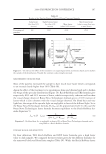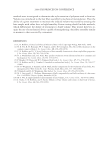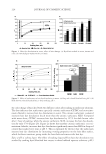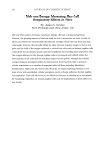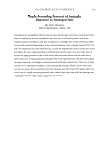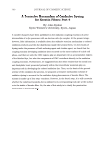JOURNAL OF COSMETIC SCIENCE 172 MATERIALS AND METHODS DESIGN AND CONSTRUCTION OF A THREE-DIMENSIONAL LASER STEREOMETER A three-dimensional laser stereometer was constructed based on laser triangulation tech- nology, allowing for measurement of three-dimensional surface plots. Utilizing a refl ec- tive laser in conjunction with a two-dimensional translation stage, an instrument was constructed that was capable of scanning a substrate in the x- and y-direction while at the same time measuring the distance from the laser to the surface of the substrate. The laser component of the instrument, referred to as Smart Sensor unit, consisted of a diffuse refl ective measurement sensor head (ZX-LD100L), series communications interface (ZX-SF11), and a laser measurement amplifi er (ZX-LDA11), all manufactured by Om- ron Corporation, Kyoto, Japan. The measurement sensor head has a measurement range of 6–14 mm and beam dimensions of 1 mm in width by 4 mm in length. The two- dimensional translation stage was constructed utilizing two NLS4 Series Precision Linear Stages manufactured by Newmark Systems, Mission Viejo, CA, U.S. (Model NLS4- 12-25). As shown in Figure 1, the two-dimensional translation stage and the laser system are mounted on a black anodized optical board with dimensions of 36 in. × 24 in. × ½ in.—purchased from Edmund Optics, Barrington, NJ, U.S. (Model A03-680). In order to coordinate data collection from the laser component with movement of the two- dimensional stage, a software program was written using Visual Basic 6.0 (Microsoft, Redmond, WA, U.S.) allowing for automated control of the three-dimensional laser stereometer. PRINCIPLE OF LASER TRIANGULATION The laser device utilized in this work operates based on the principle of laser triangula- tion. Light is sent from the laser diode, located in the laser sensor head, and is refl ected by the surface of the substrate under study, thereby sending the light back to the sensor where it is focused via lenses onto a charge-coupled device (CCD). The resulting path length of the light forms a triangle with the distance between the laser diode and CCD Figure 1. Photograph of the three-dimensional laser stereometer.
2008 TRI/PRINCETON CONFERENCE 173 comprising one leg, while the distance between both components and the surface of the substrate forming the other two legs. Based on set angles and distance of the CCD and laser diode devices, the distance from the sensor to an object may be calculated. Depend- ing on the distance of the laser to the substrate, the refl ected light will strike the surface of the CCD in a different position allowing for measurement of distance. HAIR SUBSTRATES A variety of hair types were examined, which consisted of European dark brown straight hair as well as dark brown European hair characterized by various degrees of curvature, such as straight, very curly, and frizzy hair. Measurements were also performed on Natural African Kinky hair. All hair was purchased from International Hair Importers & Prod- ucts, Inc., Glendale, NY, U.S. Straight hair tresses were constructed by gluing 2 g of fi - bers to a 1.5 in. × 1.5 in. Plexiglas tab with Duco cement. The resulting dimensions of straight hair tresses were 6.5 in. in length and 1.25 in. in width. The masses of the straight, very curly, and frizzy hair were variable and are indicated in the Results and Discussion section of this report. We also examined the effect of a bleaching process on the measured topographical plot and volume of hair. To bleach hair, 120 g of commercial bleaching powder (BW 2 – Clairol Professional, Procter & Gamble Company, Cincinnati, OH, U.S.) was mixed with 147 mL of 20 volume clear developer (Emiliani Brothers, Union, NJ, U.S.). After thorough mixing with a spatula, European dark brown hair was treated with this mixture and allowed to react for 30 minutes. The hair was then sham- pooed with 3% (w/w) ammonium lauryl sulfate (ALS) followed by rinsing. To examine the effect of bleaching on the fi ber assembly properties of hair, we utilized an atypical drying technique. After wetting, excess water was removed from the tress by sliding two fi ngers (index and middle) along the length of the hair tress allowing all of the fi bers to remain together. The hair tress was then allowed to air-dry overnight at ambient tem- perature and humidity (25°C and 50% RH). INVESTIGATED MOLECULES The effect of various polymers were tested in order to evaluate their ability to either in- crease volume for bleached hair or retain volume for hair subjected to stress stimuli such as high humidity or external forces. The following polymers, manufactured by ISP (Wayne, NJ), were utilized and their respective commercial names are provided: VCL/ VP/DMAEMA (Advantage LCA), VP/acrylates/lauryl methacrylate copolymer (Styleze 2000), Polyimide-1 (Aquafl ex XL-30), Polyquaternium-55 (Styleze W-20), VP/DMAPA acrylates copolymer (Styleze CC-10), Polyquaternium-11 (Gafquat 755N), Polyquaterni- um-69 (AquaStyle 300), isobutylene/ethylmaleimide/hydroxyethylmaleimide copolymer (Aquafl ex FX-64), and VP/VCL/DMAPA acrylates copolymer (Aquafl ex SF-40). The acronyms VCL, VP, DMAEMA, and DMAPA are used to represent the monomer units vinyl caprolactam, vinyl pyrrolidone, dimethylaminoethyl methacrylate, and dimethyl- aminopropyl methacrylate. Polyimide-1 may more specifi cally be described as isobu- tylene/dimethylaminopropyl maleimide/ethoxylated maleimide/maleic acid copolymer. We examined the commercially available polymer as well as a high molecular weight analog. Several samples of PVP (supplied by ISP, Wayne, NJ) were tested and con- sisted of PVP K30 (Mw = 60,000 Da), PVP K90 (Mw = 1,300,000 Da), and PVP K120
Purchased for the exclusive use of nofirst nolast (unknown) From: SCC Media Library & Resource Center (library.scconline.org)














































































